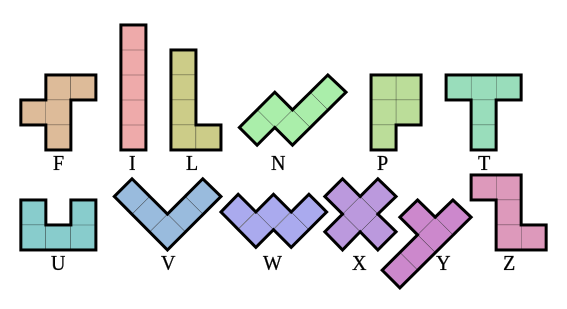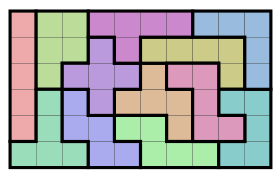
In 1965, as they were writing the first draft of 2001: A Space Odyssey, Stanley Kubrick showed Arthur C. Clarke a set of 12 plastic tiles. Each tile consisted of five squares joined along their edges. These are known as pentominoes, and a set of 12 includes every possible such configuration, if rotations and reflections aren’t considered distinct. The challenge, Kubrick explained, is to fit the 12 tiles together into a tidy rectangle. Because 12 five-square tiles cover 60 squares altogether, there are four possible rectangular solutions: 6 × 10, 5 × 12, 4 × 15, and 3 × 20. (A 2 × 30 rectangle would be too narrow to accommodate all the shapes.)
Clarke, who rarely played intellectual games, found that this challenge “can rather rapidly escalate — if you have that sort of mind — into a way of life.” He stole a set of tiles from his niece, spent hundreds of hours playing with it, and even worked the shapes into the design of a rug for his office. “That a jigsaw puzzle consisting of only 12 pieces cannot be quickly solved seems incredible, and no one will believe it until he has tried,” he wrote in the Sunday Telegraph Magazine. It took him a full month to arrange the 12 shapes into a 6 × 10 rectangle — a task that he was later abashed to learn can be done in 2339 different ways. There are 1010 solutions to the 5 × 12 rectangle and 368 solutions to the 4 × 15.

But “The most interesting case, however, is that of the long, thin rectangle only 3 units wide and 20 long.” Clarke became fascinated with this challenge when Martin Gardner revealed that only two solutions exist. He offered 10 rupees to anyone who could find the solutions, and was delighted when a friend produced them, as he’d calculated that solving the problem by blind permutation would take more than 20 billion years.
Clarke even worked the 3 × 20 problem into his 1975 novel Imperial Earth. Challenged by his grandmother, the character Duncan struggles with the task and declares it impossible. “I’m glad you made the effort,” she says. “Generalizing — exploring every possibility — is what mathematics is all about. But you’re wrong. It can be done. There are just two solutions; and if you find one, you’ll also have the other.”
Can you find them?

